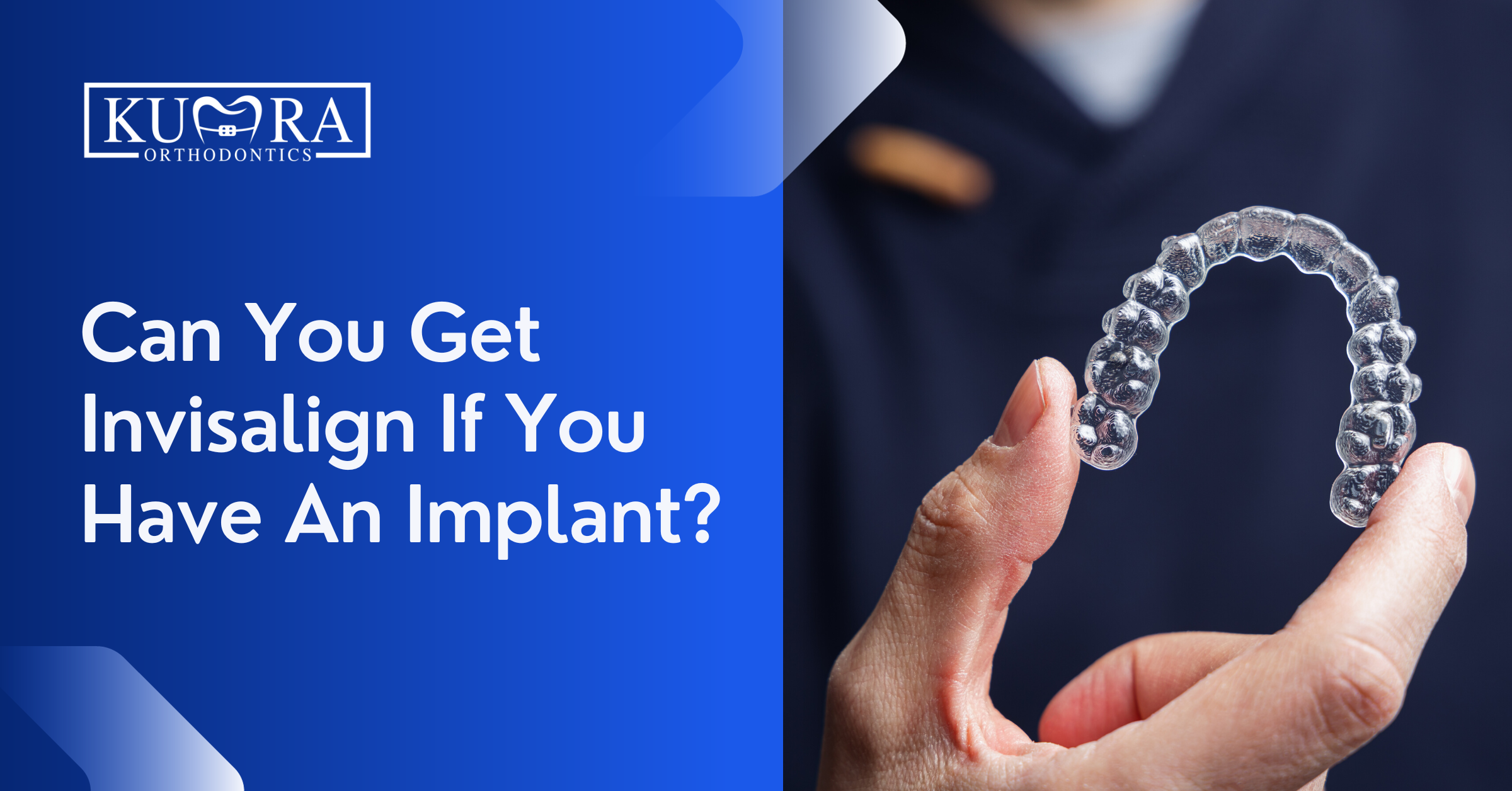The intersection of dental implants and Invisalign can seem like a tricky crossroads. If you’re someone considering both, you might find yourself asking, Can I get Invisalign if I have an implant? At Kumra Orthodontics, we’re here to simplify this for you and answer all your queries.
Dental implants are a widely embraced solution for replacing missing teeth, offering a durable and natural-looking addition to your smile.
On the flip side, Invisalign is a revolutionary way to straighten teeth without the need for traditional braces. It uses custom-made aligner trays that are comfortable, virtually invisible, and fit perfectly over your teeth. But what happens when you need both? Can a dental implant work in harmony with Invisalign?
Whether you’re just beginning your journey towards a healthier smile or contemplating adding Invisalign to your dental implant, we’ve got you covered. Let’s venture on this journey together and unravel the complexities of dental health.
What are Dental Implants?
Dental implants have revolutionized the field of dental health, providing a robust and efficient solution for those missing one or more teeth. But what exactly are they? Dental implants are made up of two main components.
The first is a titanium post that is surgically inserted into your jawbone, acting as a root for the artificial tooth. The second part is a crown, which is designed to look and function exactly like a natural tooth and is attached to the post.
The beauty of dental implants lies in their durability and effectiveness. They offer a sturdy base for the crown, making them a long-lasting option. More than just improving the aesthetics of your smile, dental implants restore functionality. It means you can eat your favorite foods and speak with confidence, just as you would with your natural teeth.
What is Invisalign?
Invisalign, a breakthrough in orthodontic treatment, offers a modern alternative to traditional braces. It’s an innovative solution that eliminates the need for metal brackets and wires, making it easier for you to get Invisalign treatment and achieve a straighter smile.
Invisalign involves a series of custom-made, clear aligners designed to fit your teeth perfectly. These aligners gradually shift your teeth into the desired position over time, effectively aligning your smile without any discomfort.
One of the key features that sets Invisalign apart from traditional braces is its near-invisibility. Its clear design makes it a less noticeable alternative to braces, allowing you to undergo treatment discretely. Additionally, these aligners are removable, meaning you can comfortably eat your favorite foods and maintain your regular oral hygiene routine without any hindrance.
Typically, you’ll need to switch to a new set of aligners every two weeks. This ensures that your teeth continue to shift towards their final, desired position. Despite its many advantages, it’s important to note the limitations of Invisalign. It may not be suitable for severe cases of misalignment or complex dental issues. Therefore, a consultation with an orthodontist is essential to determine if Invisalign is the right treatment for you.
With its seamless blend of comfort and convenience, Invisalign has quickly gained popularity among adults and teenagers alike. It’s the perfect solution for those seeking a straighter, more confident smile without the noticeable look of traditional braces.
Can You Get Invisalign If You Have an Implant?
Having a dental implant does not completely rule out the possibility of undergoing Invisalign treatment. Although the dental implant itself remains stationary, the natural teeth surrounding it can still be adjusted. Therefore, even with an implant, Invisalign treatment can be a viable option.
It’s important to note that such a situation necessitates a customized treatment plan. The orthodontist will craft a strategy focusing on shifting only the natural teeth while leaving the implant unaffected. Such a plan requires expertise and precision, reinforcing the need for detailed discussions with the orthodontist. Gaining clarity about how the Invisalign treatment can be tailored around the dental implant will instill confidence in the patient about the process and the outcome.
Related: Is It Possible to Wear Invisalign When You’re Missing Teeth?
Invisalign with Dental Implants: Before or After?
The order in which patients opt for Invisalign and dental implants depends largely on individual dental circumstances.
Orthodontists usually advise patients to complete the Invisalign treatment before getting a dental implant. As Invisalign is designed to shift natural teeth but cannot move an implant, it makes sense first to align the teeth correctly and then place the implant.
Remember, every dental case presents unique challenges. The orthodontist will carry out a thorough assessment of the patient’s specific dental condition.
Factors such as the current alignment of the teeth, the location of the missing tooth, and overall oral health are taken into consideration. Based upon this comprehensive evaluation, the orthodontist will provide expert advice on the optimal sequence of treatments.
Maintaining open communication with the orthodontist and diligently following their professional guidance ensures the successful integration of both Invisalign treatment and dental implants. This collaborative approach helps ensure that both treatments work together to enhance oral health and deliver a radiant, beautiful smile.
Benefits of Pairing Invisalign with Implants
In the realm of modern dentistry, innovations like Invisalign and dental implants have revolutionized the way we approach oral health issues. When these two treatments are paired together, they can provide a comprehensive solution to an array of dental concerns.
The powerful combination offers a host of benefits that go beyond just enhancing the aesthetics of your smile; they contribute significantly to overall oral health, functionality, and self-esteem.
Dramatically Improved Aesthetics
The aesthetic transformation that comes from combining Invisalign treatment with dental implants is truly remarkable. Dental implants serve as a robust replacement for missing teeth, seamlessly blending in with the natural teeth and restoring the completeness of your smile.
Simultaneously, Invisalign works to straighten any misaligned teeth, ensuring that your smile is not only complete but also beautifully aligned. The result? A harmonious, attractive smile that you’ll be proud to show off.
Enhanced Functional Efficiency
The functional efficiency of your mouth is significantly improved when dental implants and Invisalign are used in conjunction. Dental implants act as a sturdy replacement for missing teeth, allowing you to eat a variety of foods and articulate your words more clearly.
On the other hand, Invisalign works on correcting your bite alignment, contributing to a more efficient and comfortable chewing process. Together, they restore and enhance the functionality of your mouth.
Long-Term, Durable Results
One of the most appealing aspects of both dental implants and Invisalign is their durability. Dental implants are crafted from strong, biocompatible materials like titanium, allowing them to last a lifetime with appropriate care.
Likewise, the results achieved with Invisalign treatment can be maintained for the long term with the consistent use of retainers. This means that the investment you make in these treatments will reap rewards for years to come.
A Significant Boost in Self-Esteem
Undergoing a significant dental transformation with the help of dental implants and Invisalign can do wonders for your self-esteem. The confidence that comes from having a gap-free, straightened smile can be life-changing.
You may find yourself smiling more often, participating more in social situations, and even seeing improvements in your professional life.
Prevention of Future Dental Issues
Pairing dental implants with Invisalign can also play a crucial role in preventing future dental issues. Dental implants help prevent bone loss in the jaw that can occur when teeth are missing, maintaining the structural integrity of your face.
Meanwhile, by straightening misaligned teeth, Invisalign reduces the risk of tooth decay and gum disease, as straight teeth are easier to clean effectively. Together, they help maintain and improve your overall oral health.
Needing an orthodontic appointment?
Visit Kumra Orthodontics Washington, DC or Kumra Orthodontics Stafford, VA, and request an appointment with us!
Invisalign with Other Dental Work
Invisalign treatment is highly versatile and can often be integrated into a larger, more comprehensive dental plan. The plan may involve addressing a range of issues, such as missing teeth, crowns, and other dental work. Let’s delve deeper into how Invisalign interacts with these elements.
Can You Get Invisalign with Missing Teeth?
Absolutely! Invisalign can definitely be an option, even if you have one or more missing teeth. In many cases, Invisalign can be incorporated into a broader treatment plan designed to address the issue of missing teeth.
The clear aligners can be strategically used to create the necessary space for future dental restorations such as implants or bridges. This provides a comprehensive and aesthetically pleasing solution for improving your smile.
Can You Do Invisalign with Crowns?
In most scenarios, having crowns—artificial tooth caps used to cover damaged or decayed teeth—does not preclude you from undergoing Invisalign treatment. However, the presence of crowns may require slight adjustments to the fit of the aligners.
It’s always advisable to have a detailed discussion with your orthodontist about your specific circumstances. This will help ensure that all components of your dental work, including crowns, are taken into consideration and harmoniously integrated with the Invisalign treatment plan.
Invisalign with Implant FAQs
Can you get a dental implant while wearing Invisalign?
Typically, dental implants are placed after the completion of Invisalign treatment. This is because dental implants are fixed into the jawbone and cannot be moved once they’re installed. However, in some cases, your orthodontist might plan your Invisalign treatment to create space for a future implant. It’s important to discuss your specific situation with your orthodontist to determine the best course of action.
Can Invisalign move dental implants?
No, Invisalign cannot move dental implants. Dental implants are surgically placed into the jawbone and act like the roots of natural teeth, making them immovable. However, Invisalign can effectively move the natural teeth around an implant to improve alignment and bite.
What are the risks of getting Invisalign with an implant?
In general, there are minimal risks associated with getting Invisalign with an implant. However, since dental implants cannot be moved, it’s crucial to plan the Invisalign treatment carefully to ensure a successful outcome.
Improper planning could potentially result in misalignment or a poor bite. As always, it’s essential to discuss your treatment plan in detail with your orthodontist to understand all potential risks and benefits.
Begin Your Journey to a Radiant Smile Today – Schedule Your Consultation Now!
At Kumra Orthodontics, our team of expert orthodontists is committed to providing you with personalized dental care solutions that meet your unique needs. Whether you’re considering Invisalign, dental implants, or a combination of the two, we are here to guide you every step of the way.
We believe in creating beautiful smiles that boost confidence and promote overall oral health. Don’t wait any longer to start your journey towards a healthier, more radiant smile. Book an appointment with us today, and let us transform your smile into your most confident asset.



